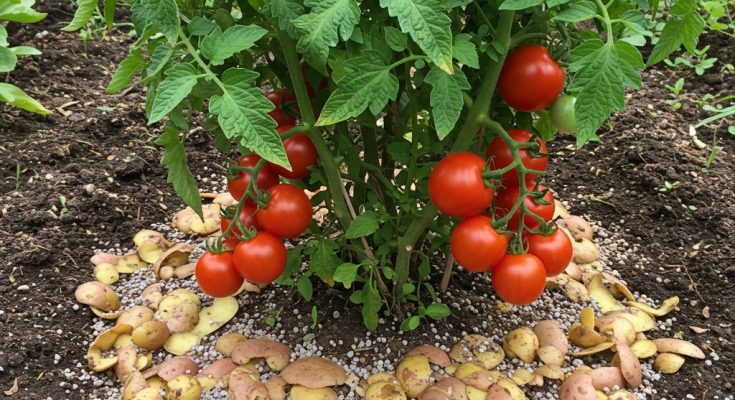This method is perfect for gardeners who want to reuse organic waste, reduce reliance on chemical fertilizers, and encourage faster, healthier plant growth—all without spending extra money.
Why Potato Skins?
Potato peels are often discarded during meal prep, but they’re loaded with nutrients that plants love:
-
-
Potassium (K): Essential for flower and fruit development and overall plant strength.
-
Phosphorus (P): Supports root growth and seed formation.
-
Magnesium and Iron: Help with chlorophyll production and photosynthesis.
-
-
Starch and Carbohydrates: Feed beneficial soil microbes, boosting microbial activity.
Soaking these peels extracts these nutrients into a water-based solution that your plants can absorb quickly, giving them an organic growth boost.
What You’ll Need
-
-
Potato peels from 3–5 medium potatoes (avoid green or sprouting skins)
-
2 liters of clean water (preferably non-chlorinated)
-
A large glass or plastic container with a lid
-
-
A strainer or cheesecloth
-
Optional: A blender for faster extraction
Step-by-Step Instructions
1. Prepare the Potato Peels
Wash the potatoes well before peeling to remove any dirt or chemical residues. Collect the peels in a clean container. Avoid using peels that show signs of rot or mold.
2. Soak the Peels
Place the peels in your container and pour in 2 liters of water. Cover the container loosely to prevent contamination while allowing airflow. Let the peels soak for 3 to 5 days. During this time, the nutrients from the peels will leach into the water, and beneficial microbes will begin to multiply.
3. Optional: Blend for Faster Results
If you want to speed up the process, you can blend the peels with water to create a slurry. Let it sit for 24–48 hours, then strain.
4. Strain and Store
Once the soaking period is complete, strain the mixture using a fine mesh strainer or cheesecloth. The resulting liquid is your organic fertilizer. Pour it into a clean bottle or container with a lid and use it within one week for best results.
How to Use the Fertilizer
For Garden Plants:
Dilute the liquid fertilizer at a 1:2 ratio (1 part fertilizer to 2 parts water) and pour it around the base of your plants once a week. This method works well for vegetables, herbs, and flowering plants.
For Indoor Plants:
Use a more diluted mixture—1 part fertilizer to 4 parts water—to avoid overwhelming smaller root systems. Apply once every two weeks.
For Seedlings:
Use a highly diluted mix (1:5) and apply sparingly to avoid root burn.
As a Foliar Spray (Optional):
Strain the liquid thoroughly and use a spray bottle to mist plant leaves early in the morning or late afternoon. This provides a quick nutrient boost, especially beneficial during the flowering stage.
Benefits of Potato Skin Fertilizer
-
-
Boosts Growth Naturally:
The potassium and phosphorus in potato peels help plants grow faster, develop stronger roots, and produce more flowers or fruits. -
Improves Soil Health:
The fermented liquid introduces beneficial microorganisms that improve soil fertility and structure over time. -
Reduces Waste:
Instead of throwing potato peels away, you’re turning kitchen scraps into valuable garden input—perfect for zero-waste gardening.
-
-
Safe for All Plants:
Unlike synthetic fertilizers that can burn or stress plants if overused, this organic solution is gentle and enriching when used properly. -
Cost-Effective:
No need for commercial fertilizers or expensive soil amendments—just use what’s already in your kitchen.
Tips for Best Results
-
-
Use Fresh Peels: Old or moldy peels can introduce harmful bacteria or fungi.
-
-
-
Avoid Chlorinated Water: Chlorine can kill beneficial microbes. If using tap water, let it sit out for 24 hours before use.
-
Apply Regularly: Consistency is key. Weekly applications will gradually improve plant health and soil quality.
-
Store in a Cool Place: Keep unused fertilizer in a cool, shaded spot to prevent spoilage.
-
Final Thoughts
Creating liquid organic fertilizer from soaked potato skins is one of the simplest and most effective DIY gardening hacks. It supports strong plant growth, enriches the soil naturally, and reduces kitchen waste—all while saving money. Whether you’re growing vegetables, flowers, or houseplants, this homemade solution can give your garden the extra boost it needs to thrive.
Give it a try, and you may be surprised by how much your plants appreciate this natural, nutrient-rich tonic.
